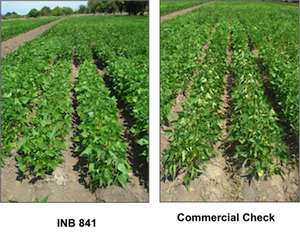Posted: February 24, 2017
Bean scientists from various disciplines work together to develop heat tolerant bean to promote food security
Tepary bean (Phaseolus acutifolius) was a mainstay of Native American diets in the dry southwest and northern Mexico for centuries before Europeans knew of the continent that blocked their way to China. Tepary is now largely a biological artifact relegated to the shelves of gene banks - or is it? What enigmas lie at the heart of dryland America's best kept secret?
For years common bean breeders have attempted to tap its unique traits of disease and insect resistance, and with some limited success. But using tepary for bean breeding is all the more tantalizing as the threat of climate change looms ever larger, and as temperature records the world over are shattered. The origins of tepary in the hot dry edges of deserts make it a natural for the future, though its very small seed and viney plant type make it undesirable in itself as a crop for farmers today. Rather, breeders would like to steal its best gems - genes that can support hell on earth - and use those gems to make a better common bean.
The good news is, we are well on the way to this goal, or at least a good part of it. Seed of previous attempts to develop interspecific crosses between common bean and tepary were drawn out of the cold room at the International Center for Tropical Agriculture (CIAT by its Spanish acronym) and were tested under conditions of drought. Most such lines were poorly adapted and offered little hope, but the best two or three were salvaged and crossed among themselves to create still another generation of breeding lines. In a second evaluation under drought, a set of very unusual "sister lines" were observed that maintained their leaves upright and crisp when everything else in the field wilted sadly under the tropical midday sun (see photo below). This was the first clue that something unusual was at hand. So was born the line INB 841. Indeed, when this line was used as a parent in crosses with other common beans, many progeny likewise did not wilt. Furthermore, when planted at lower altitudes in Colombia with night temperatures that did not go below 22oC, those progeny continued to produce grain. Evidence of heat tolerance!
The next chapter in this story unfolds in Puerto Rico in the Caribbean, where USDA scientist Timothy Porch works on heat tolerance of bean. Here again INB 841 expressed tolerance to high temperatures, and maintained good pollen viability - the Achilles heel of common bean in the face of heat. Tepary genes were protecting the common bean against one of its greatest threats of climate change!
Enter biotechnology center stage. Back at CIAT molecular biologist Bodo Raatz had analyzed the genome of INB 841 and many other interspecific lines to determine where in the bean chromosomes the tepary genes had landed. In the case of INB 841 the surprise was that it has very little tepary blood in it - indeed, a small segment on chromosome 8 may be all that it has of tepary. This segment contains 70-some genes, including at least one that has been reported as coding a "heat shock protein. " Voila!
Where are the progenies of INB 841 today? INB 841 was crossed to other lines to obtain even better drought tolerance and more attractive seed color, and a number of red seeded lines of Central American type and with the heat tolerance are being tested in the CRIB project and in other national programs. A Costa Rican student completed his PhD dissertation that confirmed that some of these lines have excellent pollen viability in the face of high temperatures. In El Salvador such lines produced grain under combined stress of heat and drought in San Miguel province where no one had ever grown beans before. One line is being considered for release in Honduras. Since the sequence of the tepary segment is known, backcrossing this segment into other lines will begin soon with the help of marker assisted selection.
Thus, a happy marriage of field evaluation, physiological study, bean genomics and international cooperation results in technology that can maintain beans at the forefront of the battle for food and nutrition security. And that is what bean science is all about.


